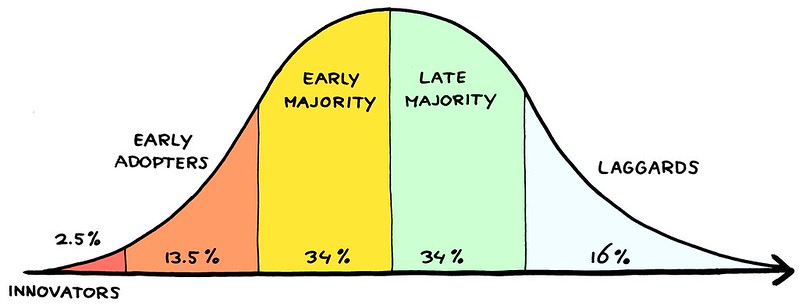Reading Time: 5min |
Today I had the pleasure of discussing with an exciting conversation partner: Mirko Reul, a postdoc at the University of Lausanne, is currently providing scientific support for the Agripath project and had some exciting insights on how to introduce digital, green solutions and thus achieve behavioral change – what works well and what doesn’t. A crucial question for any innovation.
Here is a summary and the most important lessons learned from the exciting discussion about the introduction of green innovations:
About Agripath
Agripath is a research project that uses digital tools to promote sustainable agriculture, particularly among smallholder farmers in the Global South. The focus is on smallholder farmers, as they are responsible for around 70% of global food production. The part of the project led by Mirko uses training and other measures to motivate farmers to adopt more sustainable and climate-resilient practices. A concrete example of this is “mulching”, covering the soil with organic material to increase soil fertility and thus prevent soil erosion and keep the land ecologically usable.
Challenges and solutions
As you can imagine, many challenges arose during the introduction and cooperation with farmers in countries such as India. From a western perspective in particular, they were often difficult to understand at first.
At second glance, it makes sense: the local conditions are completely different and the smallholders have different prior knowledge, beliefs and decision-making processes that outsiders first have to learn. For example, decision-making processes among smallholders are often family-based and therefore male-dominated.
The prevailing mistrust of information and help from outsiders is a recurring pattern that Mirko has also observed in other research projects. He is therefore working intensively on how well-intentioned, helpful information needs to be communicated and underpinned in order to be accepted and used in everyday life. The most important building blocks are:
- Create incentives for sustainable practices: Many smallholder farmers are reluctant to change their usual methods because they fear short-term yield losses. One concrete example is the concern about initial productivity when switching to organic fertilizers. Possible solutions include financial incentives and the provision of microcredits for the purchase of more sustainable equipment.
- Sustainable behavioral change: A key problem is the lasting behavioral change of smallholder farmers towards more sustainable practices. One example is the resistance to switching from climate-damaging, (partly subsidized) chemical fertilizers to sustainable, organic fertilizers due to a lack of confidence in their effectiveness. Even when including financial incentives for the use of organic fertilizers, this may help in the short term – however, after the subventions ceased, chemical fertilizers were used again.
- To counteract this, projects such as Agripath rely on education campaigns and demonstration projects that show the advantages of organic methods.
- Ensuring the credibility of information: Information that reaches smallholder farmers often comes from unknown sources with their own commercial interests, which leads to mistrust. Agripath therefore works with local partners – non-governmental organizations and farmers – and uses independent, trustworthy sources of information to increase acceptance.
Lifecycle discussion on technology adoption
In the discussion about behavioral change, we stumbled upon the Technology Adoption Lifecycle, the concept of “Crossing the Chasm” and the theories of early adopters and early majority (more details to be found in the book Crossing the Chasm by Geoffrey A. Moore). Mirko emphasized that behavioral change is essential, regardless of the strength of the innovation itself. Every significant innovation needs the support of the “majority” – otherwise it will have little impact. While early adopters are already open to innovation, the early and late majority are more conservative and often need to be convinced first, before changing their behavior.

Mirko’s optimism and the research results
Despite the challenges, Mirko is optimistic that in addition to innovation, behavioral changes are important to save the planet. He refers to research findings such as this article by Constantino et al., which shows that behavioral changes are possible, even if they are difficult to measure and often occur with a delay.
These and the other discussed studies focus on publicly funded projects. For green innovators who want to successfully establish their products and solutions on the market, the studies highlighted by Mirko nevertheless offer concrete tips:
- Understand the local context: It is crucial to develop a deep understanding of the local context – i.e. the customer or user – in which the products or solutions are to be introduced. This includes taking into account cultural, social and economic factors that influence the behavior and attitudes of the target group.
- Demonstrate dynamic norms: To motivate behavior change, green innovators can use dynamic norms, which is information about how behaviors in society change over time. For example, communicating a growing trend towards more environmentally friendly products or practices can encourage others to follow suit.
- Creation and use of tipping points: Political measures and campaigns can help to create tipping points in public opinion and behavior. Green innovators should aim to recognize and leverage such tipping points in order to achieve broad acceptance and support for their products and solutions.
Key findings from the founder’s journey
Mirko’s research is crucial for green innovators and founders to successfully establish their products and services on the market. It provides fundamental insights into how adoption can take place not only in the Global South.
A key insight from the Agripath project and my conversation with Mirko is the challenge of changing behavior, especially when trying to introduce something new as an outsider. It is not effective to simply transfer solutions developed in Western countries 1:1 to other countries. Instead, it is crucial to actively involve local users in the solution-finding process.
By understanding their ideas and opinions – the market – the most relevant problems can be identified and solutions developed to ensure greater acceptance and effectiveness in implementation.
Focus on early adopters with a view to the masses
Another important aspect is the initial focus on early adopters, i.e. people who are open to new technologies and methods. This group can act as a catalyst for wider acceptance and adoption. However, it is not enough to focus exclusively on this group. It is equally important to develop strategies to reach the majority, who tend to be conservative and follow best practices. This majority is looking for solutions that have been proven to work in practice and demonstrably improve their lives. Understanding this dynamic is critical to achieving and implementing behavior change on a broad scale.
Bridging the gap between innovative solutions and their broad acceptance requires a deep understanding of the target group. This includes an awareness of the challenges and resistance associated with behavioral change. The theory from the book Crossing the Chasm offers valuable insights here and I can only recommend it to anyone working on the broad introduction of a product or service. It is important to develop solutions that are not only new and innovative (and therefore appeal to early adopters), but also have practical benefits for users and can be easily integrated into everyday life (and therefore appeal to the early majority). A well established strategy to include this into your Go-2-Market is the so-called “Beachhead Strategy”, about which I’m going to write in a another article.
How can you help Mirko?
In order to be able to help effectively, it is important to be aware of networks and similar projects. Mirko emphasizes the importance of networking and sharing knowledge in order to jointly develop effective solutions for the challenges in agriculture.
Thus, if you know someone who is doing something similar or is active in a similar area, please send me a short message in LinkedIn.
Closing Note: The big picture
The transformation of agriculture in the coming decades is crucial, especially in light of the growing world population and the challenges posed by climate change. It is important that smallholder farmers, who make up a significant proportion of the world’s food supply, become more resilient to climate change and adopt more sustainable farming practices.
Mirko reflected on the future of agriculture, particularly in India, where the increasing fragmentation of small farms through split inheritance is affecting efficiency. He questioned how food will be grown in 10 to 20 years and whether an increase in mass production can be expected. It is likely that young people will turn to other activities due to the hard work and poor pay in agriculture.
In the medium term, this could lead to more efficient but less sustainable management through mass production. Even if this makes it easier to establish sustainable standards, new challenges will arise.
Mirko Reul, PhD in political science, worked as a gardener in his youth and experienced his “worst job” as a returns processor in a logistics center – he gladly gave up the monotony and boredom. Today, he is a post-doctoral researcher working on the Agripath project to encourage farmers to adopt more sustainable and climate-resilient farming methods.
Mirko recommends the book “Seeing like a state: How Certain Schemes to Improve the Human Condition Have Failed” by James Scott. The book offers a deep insight into the complexity of governance and social reform. Scott analyzes how well-intentioned but centrally implemented top-down projects often fail because they cannot take into account local conditions and the dynamics of human behavior.
Transparency note: Text and images on this page were created with the help of AI.

